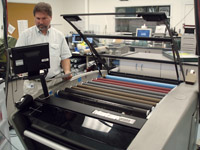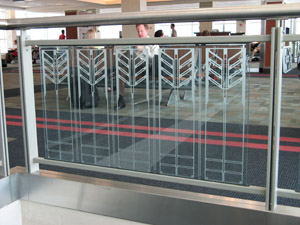
Features
Business intelligence
Contracting
Digital ceramic frit applied to glass
.. to glass. Digital short-run glass decoration...
May 9, 2008 By David Martin*
Digital short-run glass decoration gives glaziers more control and competitive pricing.
 |
Tried-and-true technologies are often challenged by new ones in today’s innovative processed glass world.
ProTemp Glass, an $18 to $20 million commercial flat glass fabricator and distributor in Concord, Ontario, has recently introduced to Canadian glaziers and glass shops the newest technology for imaging on glass. Called digital ceramic frit glass decoration technology, the new heat-applied process, patented by DecoTherm of Amherst, New York, is an alternative to sandblasting and silkscreen.
Today, computer software technology delivers new ways for decorating glass in commercial architecture and interior design. Even intricate custom designs, driven by such software as Photoshop and Auto CAD, can be efficiently created, printed and applied to glass. Digital short-run glass decoration gives glaziers better control, and competitive pricing compared to silk screen and sandblasting. Quick turnaround service from regional flat glass fabricators allows convenient pickup with the rest of the order. Just-in-time delivery reduces breakage risk.
 |
| At the fabricator’s plant, specialized IPS ‘positioning equipment’ transfers the image onto the glass. The UV heating bed heats the vinyl, carrying the image, to transfer it to the glass. A 1⁄4 inch thick panel of glass takes five minutes to process up to 180 degrees F to 200 degrees F (82 degrees C to 93 degrees C); then cools below 100 degrees F (38 degrees C) to transfer the image. A combination of heat and pressure transfers the image onto the glass. |
DecoTherm digitally transfers an image to a ceramic frit appliqué, which is then permanently fired onto the glass surface by the heat-strengthening or glass tempering process. The image has a sandblast or etched glass appearance and might be chosen from a library of stock designs. Custom design images, in high resolution, are also possible. Applications include commercial and residential windows, glass doors and interior room dividers, transoms and sidelites.
Delores Primo, ProTemp’s general manager, sees this new technology as a profitable complement to its current decorative offering to eastern Ontario glaziers and glass shops. “It’s a new process that opens up new growth opportunities for us and for our customers to expand the use of decorative glass,” she says. “The digital nature of the technology takes creativity to the next level with highly detailed, multi-coloured imaging for both custom and short-run jobs.”
Adds Primo, “We’ve done sandblasting but found it to be a very time-consuming, archaic process. It takes a specialist to do it right. If you don’t apply the proper protective coating, it’s vulnerable to surface damage from natural oils on the skin when touched. The DecoTherm process is much more durable and efficient and gives us much better detail on designs and half-tones (photographic conversions). Working from digital files, provided by DecoTherm, on ready-to-apply vinyl appliqués, we don’t need creative specialists to work with it. In terms of reproduction, it’s the difference between 400dpi resolution and about 60dpi for sandblasting.”
ProTemp recently installed an IPS applicator and plans to soon introduce the new process to small groups of customers at box lunch presentations, says Primo. “We think they will be as excited about digital-based glass decoration as we are, when they see how profitable and easy it is to work with.”
 |
| In the DecoTherm process, ink is melted onto the transfer paper. The process uses similar ink and coloured frits as used in the screen printing process. |
DecoTherm is now in its second year of setting up North American licensed architectural glass manufacturers with its revolutionary process. ProTemp joins Arch Deco Glass in City of Industry, California, and Oldcastle Glass in Louisville, Kentucky, as regional licensees across the continent.
Scott Surma, national sales manager for DecoTherm, says, “Many glaziers have been reluctant to deal with traditional glass decoration because of the inherent drawbacks and limitations of sandblasting and screen printing techniques. These include high fixed costs, long lead times, logistic problems and the lack of detailed designs.”
Surma sees this new digital process as a natural value-added product for glaziers and glass shops looking to expand their businesses into vertical markets such as hospitals and clinics, office lobbies, hotels, restaurants, upscale residential, fine retail, health clubs, airports, furniture and cabinet manufacturing and mass transit.
Primo sees DecoTherm as an ideal way for the company to work with glaziers in the Ottawa capital region. “It’s an ideal process for government buildings with large glass entry areas,” she says. -end-
Web-based order and approval process
Greg Pershyn, DecoTherm digital imaging engineer, works closely with fabricator licensees and their customers to develop custom designs. “To-date, 90 percent of the designs are originated by architects and designers, or by rough sketches from building owners who have a concept in mind,” explains Pershyn. “Sometimes fabricators provide us with camera-ready artwork, but we can help them design the artwork.
 |
 |
| In the fabricator’s tempering oven, the image is bonded to the glass at 1500 degrees F (815 degrees C), assuring a permanent, fingerprint-resistant surface that is easy to clean. | A four-station thermal printer is used to transfer the image to the vinyl appliqué. The first three stations print the colours; the last station prints theoverprint. The overprint seals in the colours before tempering. |
“Glaziers place the order through licensed DecoTherm fabricators. This takes the hassle out of the glass decoration process. The fabricator takes care of everything. My studio works with the fabricator to provide electronic proofs for final approval. The proof does two things: It shows the customer what the final artwork looks like, and it is also used to help position the design appliqué on the glass by the fabricator’s operator on the other end. The fabricators can also provide samples to help customers visualize the colours and capabilities of DecoTherm.” -end-
 |
Flexible, durable designs for all flat glass surfaces
DecoTherm Digital ceramic frit glass decoration is a patented process that offers a permanent way to place graphic designs on glass, without sandblasting or silk screening, and works equally well on
reflective and tinted glass as well as on fire-rated glass. In addition to creating half-tones, the process can combine traditional etched glass with digital technology.
The digital nature of the technology provides the ability to use half-tones for depth and dimensions in designs. Colour highlights and accents can be incorporated into any image without significant cost increase. If exposed to weather, the images should be laminated, or printed on the inside surface of the glass.
Other decorative digital processes include Glass Jet Digital ink jet printing by Tamglass; and Sentry Glass Impressions, a DuPont laminated glass product using a printed PVB interlayer. -end-
*David Martin is president of Lenzi Martin Marketing in Oak Park, Illinois.
Print this page
Leave a Reply